Make a hearty pot of Chinese chili using Sichuan ingredients to create a super rich and deep umami while keeping the essence of a traditional chili. The recipe teaches you how to make a flavorful chili paste, but you can also use chili powder to make the recipe super easy. {Gluten-Free Adapetable}

One of the complaints I’ve heard the most over the years is, how am I supposed to use the leftover Chinese ingredients I bought for a specific dish. Imagine that you’ve bought dried chili peppers, Sichuan peppercorns, and Doubanjiang to make your favorite Mapo Tofu or Sichuan Mala Chicken. After you’ve made the dishes, you’re left with all the ingredients that take up space in your pantry and lose fragrance over time. It’s such a waste!
That’s why I want to introduce you to more non-Chinese dishes that are even tastier when they incorporate Chinese ingredients. For example, this gorgeous Roasted Whole Chicken uses the traditional tea smoked duck seasoning but is much easier to make at home. I’ve made Spiced Candied Walnuts with a warm, savory spice blend that makes the sugary nuts even more addictive. And I made these finger-licking Soft Cinnamon Rolls using Chinese sesame paste. See? You can totally utilize your existing Chinese pantry to create your favorite foods with a mildly exotic flavor profile, while keeping them just as comforting as the originals.
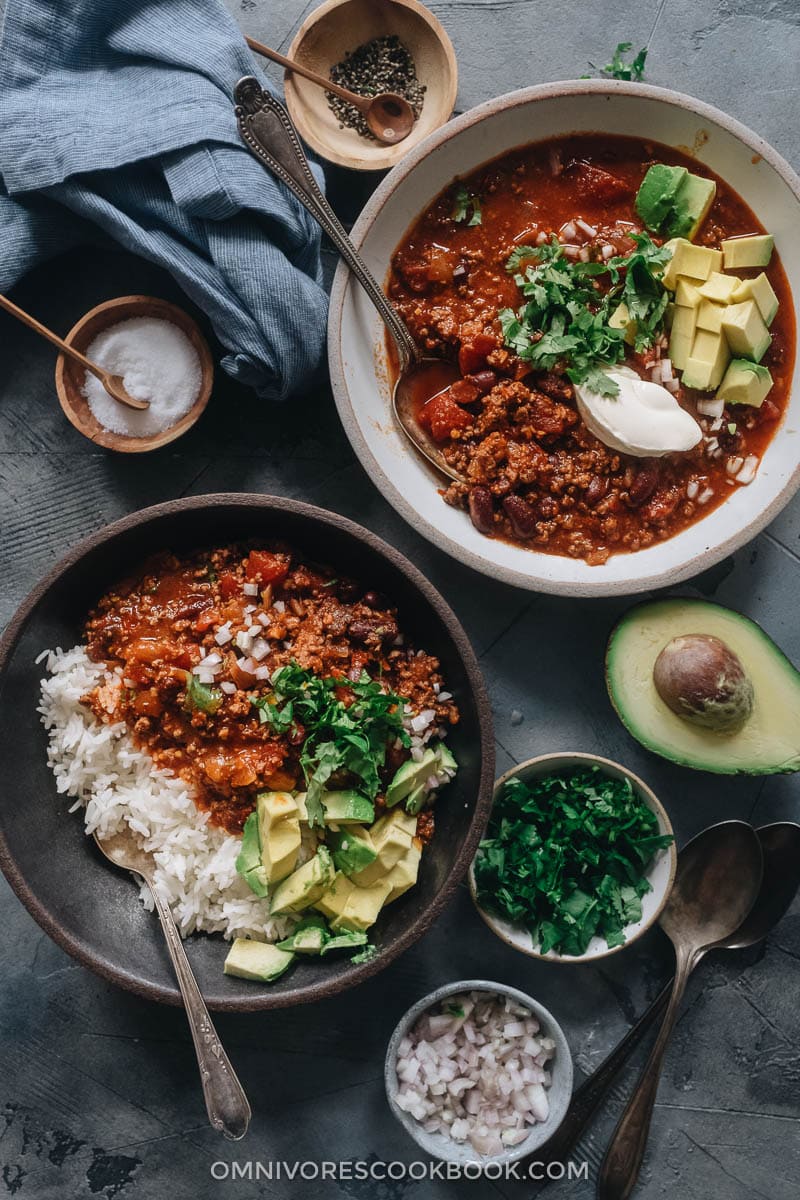
Why Chinese chili
We created this Sichuan style Chinese chili using the flavor profile of Mapo Tofu.
- The Chinese chili blend uses Sichuan peppercorns to create a distinctive fragrance and a numbing tingling sensation that makes this dish stand out.
- The chili is well-balanced and tastes just as hearty as the traditional version.
- We introduce a new method to make a chili blend that brings out the flavor of the chili peppers.
- Clean up your pantry while making something delicious that everyone will enjoy.
- The dish is perfect to make in advance and serve later. It freezes well and is suitable for meal-prep as well.
My American friends tasted the chili and they all raved about it. They commented that it’s a very well executed chili but has something unique about it that tastes so good. That’s the magic of Sichuan peppercorns!
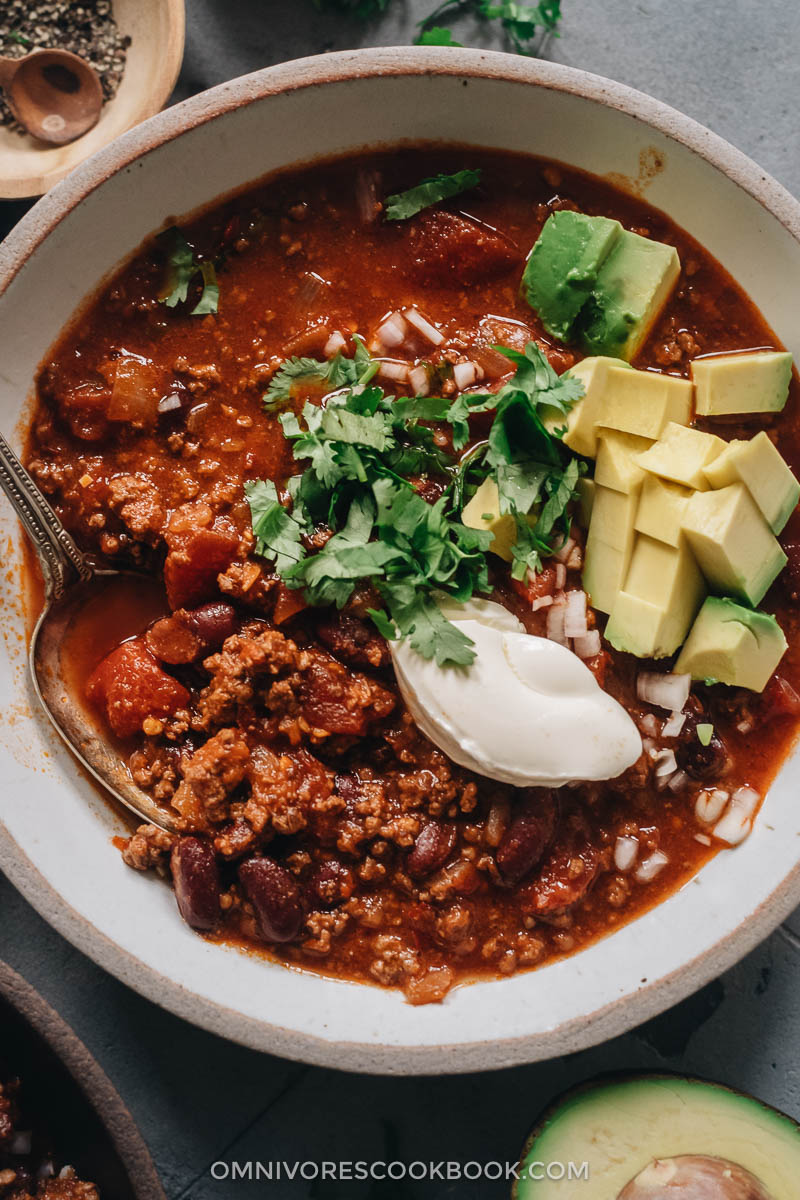
Ingredients
The recipe uses a chili blend made with Chinese ingredients:
(1) Chinese Facing Heaven dried chili peppers
Facing Heaven chili peppers are the most common in China. They have a deep red hue and taste medium-hot. They’re used abundantly in Sichuan cooking.
(2) Chinese Red Lantern dried chili peppers
These cute, round, and fat chili peppers are medium-hot and have a smoky taste. I added them into the chili paste to add smokiness to the dish.
You can find premium Facing Heaven chili and Red Lantern chili peppers at The Mala Market, which imports freshly harvested dried chili peppers directly from Sichuan.
Alternative:
If you do want a simpler cooking process or do not have these peppers, you can also use Chinese chili flakes or a regular chili blend to replace the whole dried chili peppers (tips are included in the recipe footnotes).
(3) Sichuan peppercorn
Sichuan peppercorn is the key ingredient in this recipe. It creates a very rich aroma that no other pepper will be able to replace. You can read a bit more on Sichuan peppercorns in this post.
To find good Sichuan peppercorns, the first thing to look for is the color. Fresh Sichuan peppercorns have a vibrant red color, and the numbing aroma will be right up your nose as soon as you open the package.
I highly recommend the high quality Sichuan peppercorns from The Mala Market. Fresh Sichuan peppercorns make a big impact on all your favorite Sichuan dishes and are definitely worth the investment.
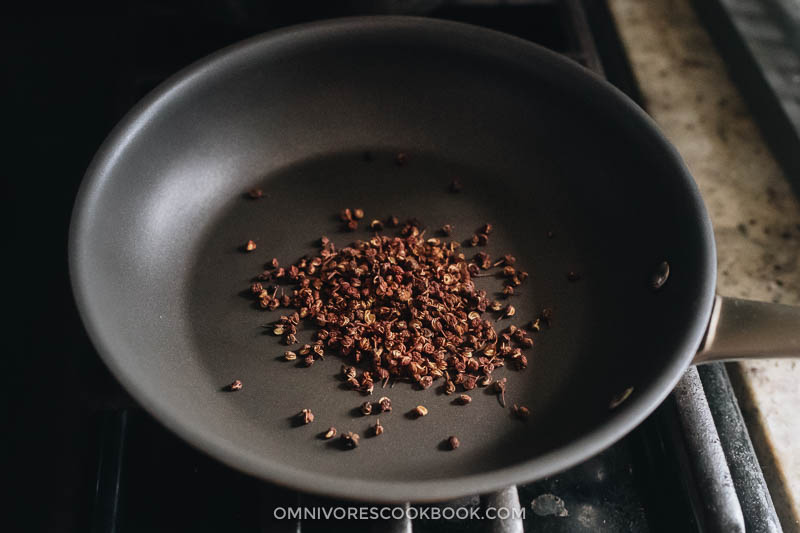
(4) Doubanjiang
Also called fermented spicy bean paste, Doubanjiang is a key ingredient in Mapo Tofu. It adds a deep fermented savory umami like soy sauce, only richer.
These days, you can even find Doubanjiang at Whole Foods. It’s also sold on Amazon. For an even better version, check out The Mala Market’s Handmade 3-Year Aged Doubanjiang. It has become my go-to brand ever since I first tried it.
Cooking process
Make the chili blend
The chili paste blend is the main star of the dish. It creates a very balanced, smoky, and not-too-spicy chili paste that is fragrant and has a unique aroma.
To make the chili blend:
- Soak the dried chili peppers in hot water to soften them
- Remove and discard the tough stems from the softened peppers
- Blend the chili peppers with the other dry ingredients
- The chili paste should be smooth and even once blended
- My immersion blender was broken so the paste wasn’t very smooth. You should try to blend the chili peppers as finely as you can. If using a bigger blender, you can add some broth to the mixture to help with the blending.
If you do not want to make the chili paste, you can use 1/3 cup of chinese chili flakes (or 1/4 cup chili powder) to replace the whole chili peppers. Grind the Sichuan peppercorns into powder in a spice or coffee grinder. Mix all the ingredients for the chili blend and toss them in a hot pan to release the fragrance. Then use the dry chili blend instead of the paste.
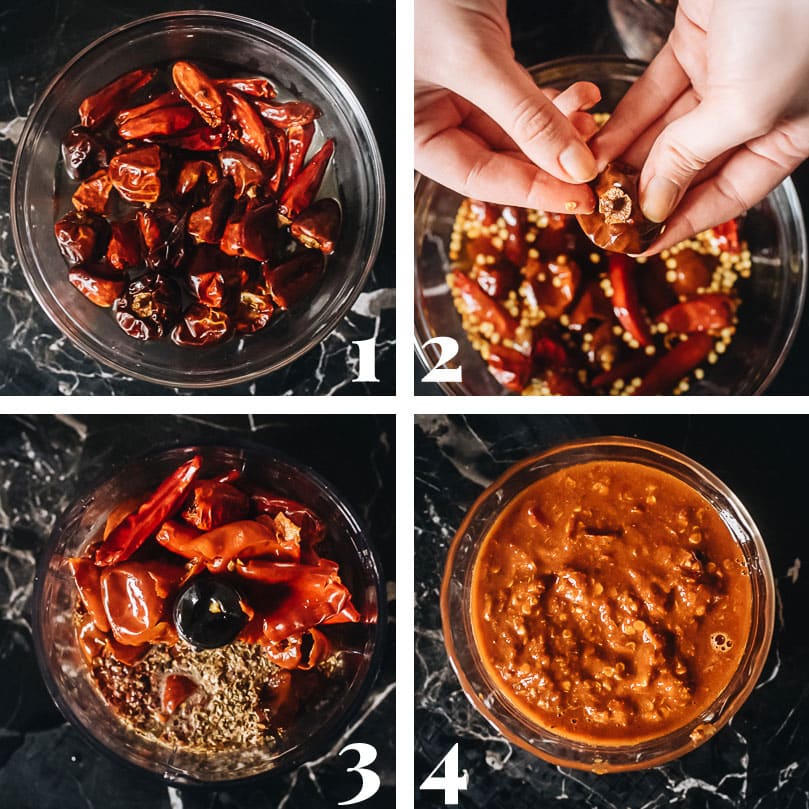
Cook the chili
This is the easy part, just like if you were making a pot of traditional chili, almost!
- Saute the onion. I keep the onion crisp at this stage, so it won’t have turned into mush by the end of cooking.
- Cook the beef and Doubanjiang. You don’t need to brown the beef perfectly. It will taste great after simmering with all the spices.
- Add the homemade chili paste and cook.
- Add the canned tomatoes and the rest of the seasonings.
- Simmer covered for 30 minutes.
- Add the beans and cook for 5 minutes.
Super easy isn’t it?
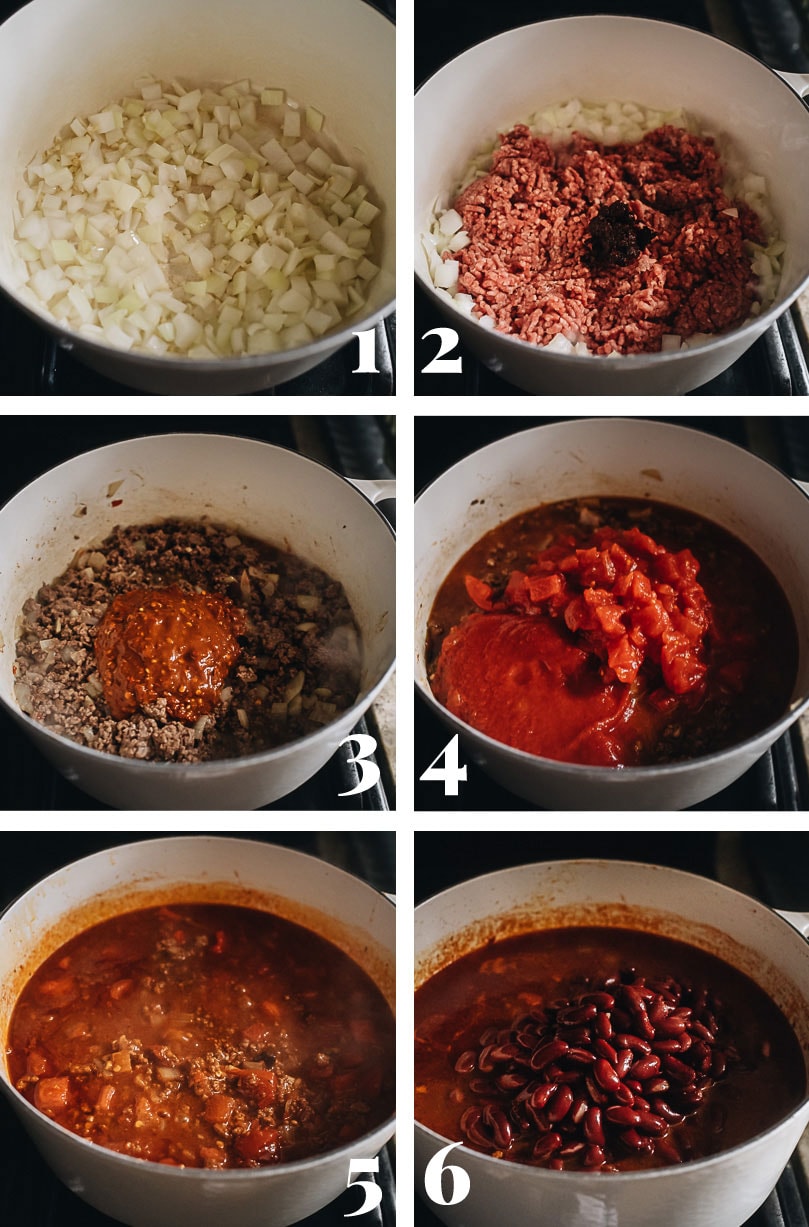
Serve and store
You can serve the chili the traditional way, with chips, crackers, or cornbread. Or simply eat it with a spoon. I enjoy serving the chili over steamed rice, China style.
For the toppings, you can go with cream cheese, sour cream, or shredded cheese. Although I highly recommend topping it with avocado. The chili is very rich and flavorful by itself, so the mild avocado will add a nice touch to it without overpowering the star.
This recipe makes a big batch, because, believe or not, it’s easier to make a big batch than a small one. You can use the chili for meal prep or freeze the leftovers for longer storage. You can also use the leftovers as pasta sauce, make it into tortilla soup, or make chili dogs!
If you want to learn more about how to use leftover chili, leave a comment to let me know! I’d love to develop some fun leftover chili recipes.
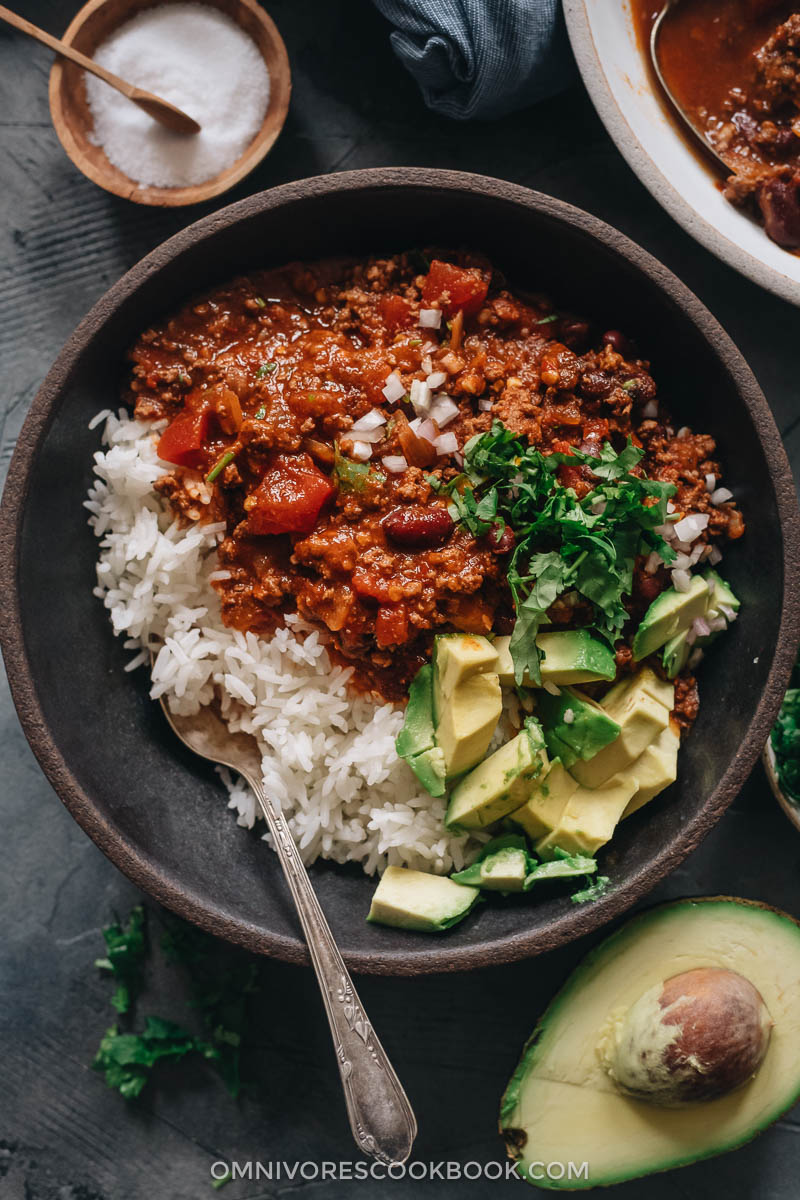
More comfort food recipes
- Korean Fire Chicken (Cheese Buldak)
- Instant Pot Pork Ribs (Chinese-Style)
- Steamed Salmon in Black Bean Sauce
- Chicken Udon Soup
- Barter-Worthy Spam Musubi
If you give this recipe a try, let us know! Leave a comment, rate it (once you’ve tried it), and take a picture and tag it @omnivorescookbook on Instagram! I’d love to see what you come up with.
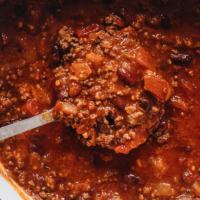
Chinese Chili (Sichuan Style)
Ingredients
Chili blend (*Footnote 1)
- 16 Chinese Facing Heaven chili peppers
- 16 Chinese Red Lantern chili peppers
- 1 and 1/2 tablespoons Sichuan peppercorns
- 2 teaspoons cumin powder
- 2 teaspoons dried oregano
- 1/2 teaspoon salt
Chili
- 1 tablespoon olive oil (or vegetable oil)
- 1 yellow onion , minced
- 5 cloves garlic , coarsely chopped
- 2 lbs (1 kg) ground beef
- 4 tablespoons Doubanjiang Chinese fermented spicy chili paste
- 1 can (28 oz) canned diced tomatos
- 1 cup canned tomato sauce about 1/2 can (7 oz. tomato sauce, or 2 tablespoons tomato paste)
- 2 tablespoons Shaoxing wine
- 1 tablespoon soy sauce
- 1 cup beef broth
- 2 can (14 oz) kidney beans , drained
Serve (Optional)
- Finely chopped cilantro
- Cubed avocado or sour cream
- Steamed rice
Instructions
Make the chili paste (Footnote 1)
- Toast the Sichuan peppercorns in a small saucepan over medium heat until you can smell the fragrance and the Sichuan peppercorns turn a little darker. Transfer the peppercorns to a small bowl and set aside.
- Soak the chili peppers in 2 cups of hot water until softened, 15 minutes or so. Use your fingers to press the air out from the chili peppers so they soak evenly. Once soaked, remove the tough stems of the chili peppers and discard them.
- Combine the soaked chili peppers, Sichuan peppercorns, cumin powder, dried oregano, and salt in a blender or in a tall glass and use an immersion blender. Add 1/2 cup of the pepper soaking water without adding the residue at the bottom. Blend until it forms a fine paste.
Cook
- Heat oil in a 5.5 quart dutch oven over medium heat and add the yellow onion. Cook and stir until the onion just starts to soften, 5 minutes or so.
- Use your spatula to move the onion to the edge of the pan and add the ground beef in the center. Add the Doubanjiang. Let cook for a minute without moving. Then stir with a spatula to break the meat into smaller pieces and coat with the Doubanjiang. Cook, stirring frequently, until the meat is cooked and turns into small pieces.
- Add the chili paste. Cook and stir for 2 minutes.
- Add the diced tomato, tomato sauce, Shaoxing wine, and soy sauce. Cook and stir for 2 minutes.
- Add the beef broth. Cook until bringing to a simmer. Turn to medium-low heat. Simmer, covered, until the beef turns soft, 30 minutes.
- Add the kidney beans and stir to mix well. Cook for another 5 minutes. Taste the chili carefully and add more salt if needed.
- Serve the chili over steamed rice. Garnish with chopped cilantro and avocado, if using. Serve as a main course.
Store
- Store the leftover chili in an airtight container in the fridge for up to 5 days or in the freezer for up to 1 month. Reheat in the microwave or on the stovetop. The beans will continue to absorb liquid during storage. You can add a splash of broth before reheating to bring back the original texture.
Notes
- If you want a faster and easier recipe, or if you do not have whole Chinese chili peppers, use 1/3 cup of Chinese chili flakes (or 1/4 cup of chili powder) to replace the whole chili peppers. Grind the Sichuan peppercorns into powder in a spice or coffee grinder. Mix all the ingredients for the chili blend and toss them in a hot pan to release the fragrance. Then use the dry chili blend instead of the paste in the recipe.
Nutrition
Lilja Walter is a part of the Omnivore’s Cookbook team and worked closely with Maggie to develop and test this recipe.
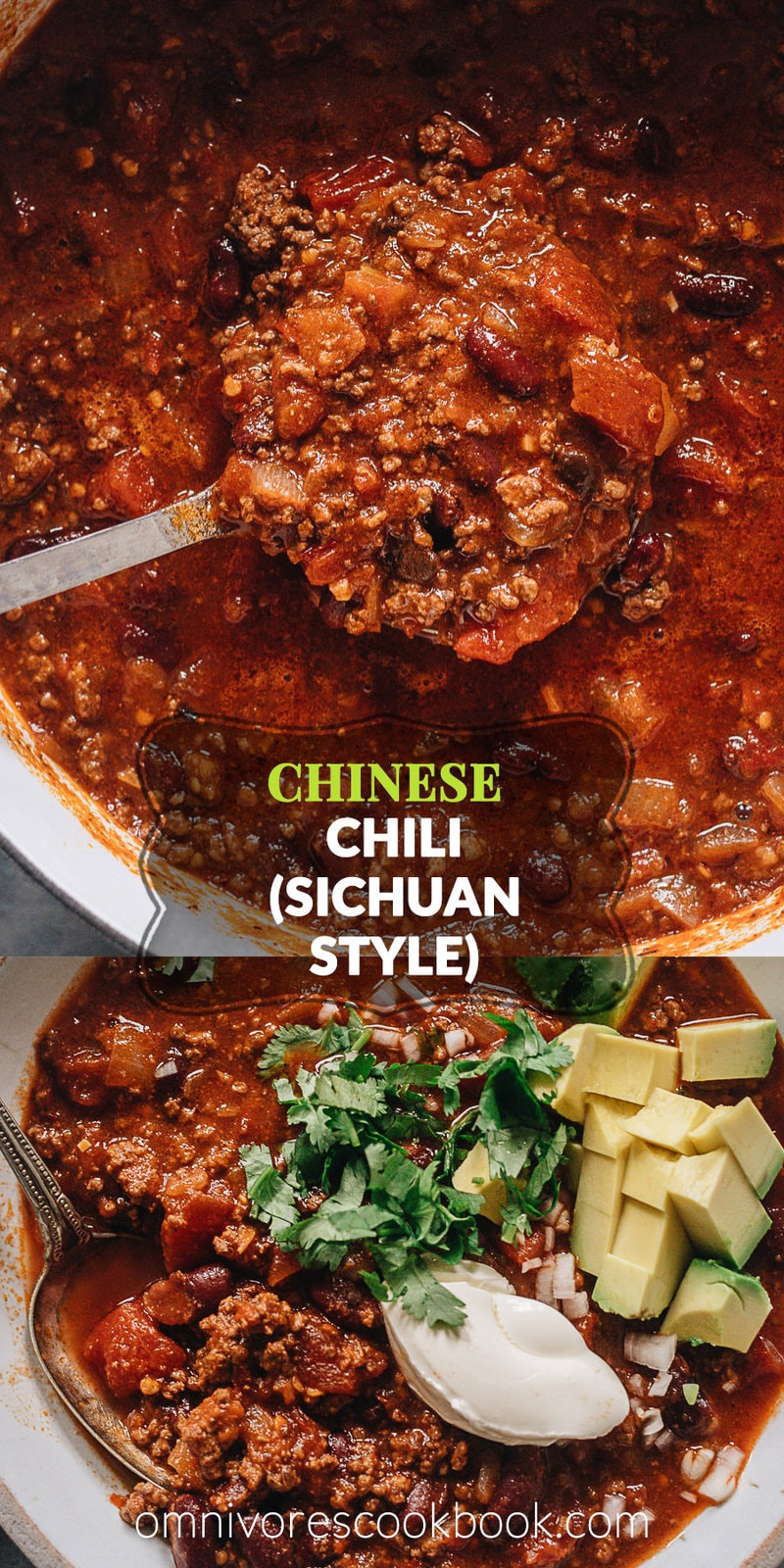













I love chili! I can already imagine how good it’s going to taste.
I made this last night and it was fabulous!!! Thank you for a great recipe it was such a nice change from traditional chili. Next time we will eat it with noodles I think – there’s plenty left over for the freezer 🙂
Hi Nancy, I’m so happy to hear you made the dish and liked it! Yeah it goes great on the noodles. Sometimes I melt some cheese on top to make it fancier 🙂
Will try this! Do you know why God made habanero peppers? To slow roast Yankee sinners 🙂 walk in beauty
What is a gluten free substitute for doubanjiang?
You can use gochujang, which is usually gluten-free. It is slightly sweeter but it should work.
Another option is to use black bean sauce plus chili flakes. The homemade one is gluten free: http://omnivorescookbook.com/homemade-black-bean-sauce/
For this recipe since you are already using dried chili peppers, maybe don’t even need the extra chili flakes, if it’s spicy enough.
Halfway through cooking and the flavours are great! But when does the garlic get added, maybe I’m not reading correctly?
I’m glad you commented on this, Rachel, before I cook this recipe and encounter the same problem as you! I’m guessing the garlic gets cooked with the onion in the first step. Too bad the author didn’t reply though!
I like it! I think I will add more cumin next time. Cumin is what really says chili to me.
i did not have access to the fresh chilis or whole peppercorns, i ended up using chili crisp and a mix of spices called “tasty pepper salt” i found at my local asian market, and it still turned out to be the best chili ive ever made. the doubanjiang really makes it i think
Is it possible to tweak the recipe if I want to make it in a crockpot?
I think you definitely can. I would cook everything the same way until step 5. Then transfer everything to a crockpot, along with the beans. Cook on high for 3-4 hours or on low for 6-8 hours.